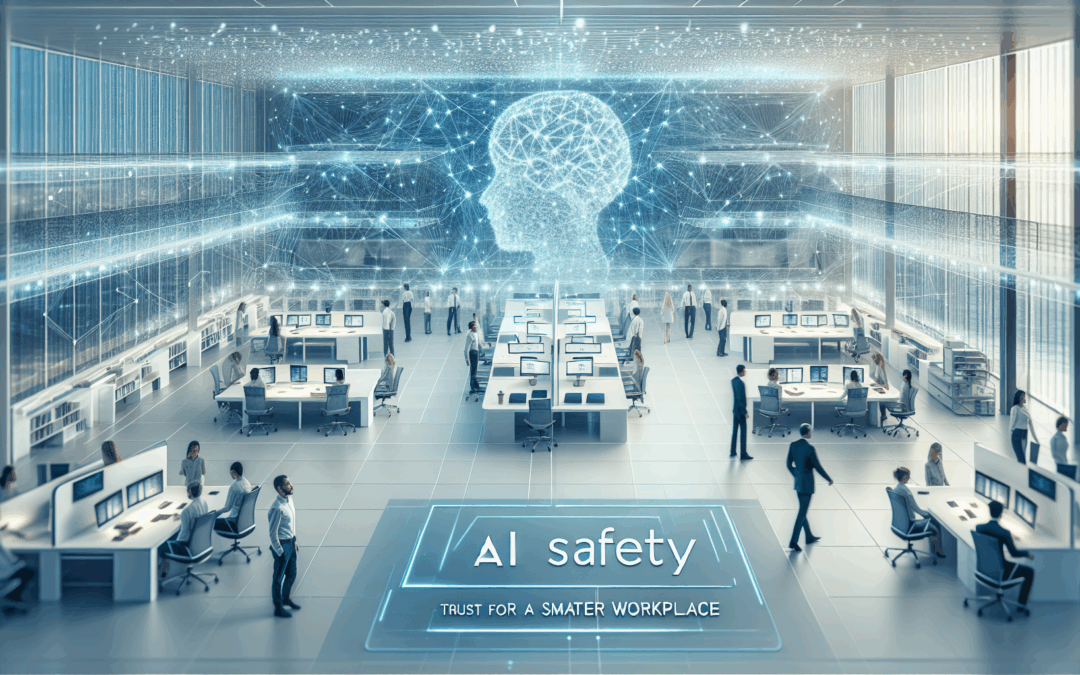Understanding the Imperative of AI Safety in the Workplace
As we plunge deeper into the digital age, Artificial Intelligence (AI) has transitioned from a futuristic concept to an everyday necessity. Businesses worldwide are embracing AI to enhance efficiency, make better decisions, and drive innovation. However, with great power comes great responsibility. The responsible use of AI is not just a moral obligation but a strategic imperative, especially when it comes to safety in the workplace.
Artificial Intelligence can boost productivity and transform work processes, but if implemented without proper safeguards, it poses risks that could jeopardise employee well-being, corporate reputation, and overall operational effectiveness. Embracing AI safety means more than just installing protective measures—it’s about cultivating a culture where workforce development aligns with technological advancement.
The Cornerstone: AI Training
AI training lies at the heart of integrating AI safely into the workplace. Without comprehensive AI training, employees may either misuse the technology or fail to understand its limitations, which could lead to costly errors and safety hazards. Effective training equips staff with an understanding of AI capabilities, potential risks, and the ethical considerations involved.
The focus should not be solely on how to use AI tools but also on recognising when AI-generated outputs need human judgment. For instance, AI may flag potential hazards or suggest interventions, but the final decision-making rests with a well-informed human operator. Building such knowledge across the workforce ensures that AI acts as an aid rather than a source of unforeseen dangers.
“AI is neither good nor evil. It’s a tool. It’s how we use it that matters.” This simple yet profound insight underscores the essence of responsibility in AI deployment.
Promoting Responsible Use of AI: Ethics Meets Efficiency
The responsible use of AI requires policies and frameworks guiding its ethical application. Organisations must establish clear guidelines outlining acceptable AI operations, limits on automation, and ways to protect data privacy and security. Transparency is key: employees should understand how AI engines arrive at decisions, especially in critical areas like hiring, performance evaluations, and safety monitoring.
Equally important is fostering an environment where workers feel comfortable reporting AI anomalies or biases without fear of reprisal. Such feedback loops refine AI models over time, enhancing reliability and safety. This approach signals that AI isn’t replacing humanity but augmenting it responsibly.
Workforce Development: Preparing People for an AI-Driven World
Technological advancement reshapes job roles and skill requirements. Workforce development strategies must align with this reality by reskilling and upskilling employees to thrive alongside AI. Whether it’s frontline staff utilising AI-powered safety sensors or managers interpreting AI analytics for risk mitigation, tailored training programmes are essential.
Companies investing in workforce development demonstrate commitment to their people and future-proof their operations. This proactive stance mitigates resistance to AI adoption, curtails potential errors, and empowers teams to leverage AI effectively without compromising safety.
Harnessing AI Productivity While Safeguarding Well-being
The promise of AI productivity is undeniable. Tools like WorkSmart AI are revolutionising processes by automating routine tasks, identifying risks proactively, and streamlining communications. Yet, these benefits must be balanced with safeguards that prioritise employee welfare.
Employers should integrate AI systems designed with human-centric principles—systems that augment rather than overwhelm, inform rather than dictate. Safety protocols must incorporate regular audits of AI performance, continuous monitoring for biases or malfunctions, and mechanisms for immediate intervention should unintended consequences arise.
In sectors where physical risk is high, WorkSmart AI platforms can provide real-time hazard detection, enabling swift responses that save lives. However, this is achievable only when the technology is embedded within a framework prioritising safety, transparency, and ethical standards.
Case Study: Transforming Safety Culture with AI
Consider a manufacturing plant that recently implemented AI-driven safety monitoring. By combining AI Training with responsible use policies, the company empowered operators to interact confidently with AI-powered sensors and analytics tools. Workforce development ensured employees could interpret AI alerts accurately and respond effectively.
The outcome? A significant reduction in workplace accidents, faster incident reporting, and improved employee morale. This example highlights how AI safety, when embraced holistically, enhances productivity (AI Productivity) without compromising well-being.
Looking Ahead: The Future of AI Safety in Workplaces
As AI continues to evolve, the landscape of workplace safety will grow even more complex. Emerging technologies like machine learning and natural language processing offer sophisticated tools but demand heightened vigilance. Continuous AI training programmes, responsible use frameworks, and dedicated workforce development initiatives will be crucial in steering AI safely.
Companies that proactively integrate AI safety practices can expect to reap substantial benefits: operational efficiencies, reduced risk exposure, and empowered employees. The shift towards such integration is not merely a trend but an essential evolution in managing the coexistence of humans and Artificial Intelligence.
Conclusion: Championing AI Safety as a Collective Responsibility
Embedding AI safely in the workplace transcends technology—it’s an organisational ethos. By prioritising AI Training, enforcing responsible use of AI, advancing workforce development, and embracing tools like WorkSmart AI thoughtfully, businesses set new standards in safety and productivity.
The journey towards AI safety is collaborative, requiring commitment from leadership and workforce alike. When done right, it transforms Artificial Intelligence from a potential risk into a resilient, dynamic asset — empowering workplaces not only to work smarter but also safer.
Get started today with Responsible use of AI license training.

